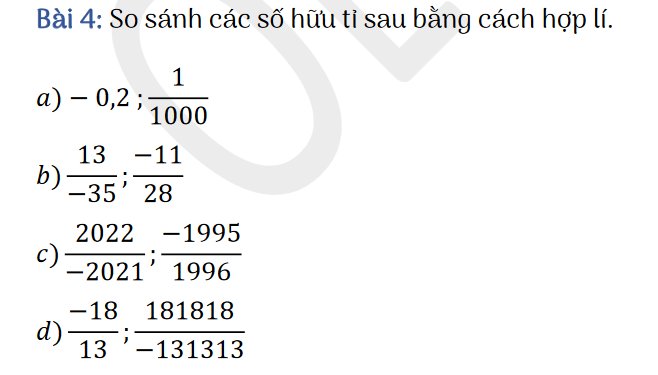Hãy nhập câu hỏi của bạn vào đây, nếu là tài khoản VIP, bạn sẽ được ưu tiên trả lời.


`@` `\text {Ans}`
`\downarrow`
`[124 - (20 - 4x)] \div 30 = 40`
`\Rightarrow 124 - (20 - 4x) = 40 \times 30`
`\Rightarrow 124 - (20 - 4x) = 120`
`\Rightarrow 20- 4x = 124 - 120`
`\Rightarrow 20 - 4x = 4`
`\Rightarrow 4x= 20 -4`
`\Rightarrow 4x = 16`
`\Rightarrow x = 16 \div 4`
`\Rightarrow x = 4`
Vậy, `x = 4.`
[124-(20-4.x)]:30=40
=>124-(20-4x)=40*30
=>124-(20-4x)=120
=>20-4x=124-120
=>20-4x=4
=>4x-20-4
=>4x=16
=>x=16:4
=>x=4

\(\dfrac{87x52x64}{58x26x16}=\dfrac{29x3x2x4}{58}=\dfrac{3x4}{1}=12\)
*Thực hiện phương pháp gạch bỏ*

Cô làm rồi em nhé:
https://olm.vn/cau-hoi/giup-em-voiii.8161766187032

a) \(1+2+3+...+x=325\)
\(\dfrac{x\times\left(x+1\right)}{2}=325\)
\(x\times\left(x+1\right)=325\times2\)
\(x\times\left(x+1\right)=650\)
\(x\times\left(x+1\right)=25\times26\)
\(x=25\)
b) Bạn xem lại đề:

a, -0,2; \(\dfrac{1}{1000}\)
-0,2 < 0; \(\dfrac{1}{1000}\) > 0
-0,2 < \(\dfrac{1}{1000}\)
b, \(\dfrac{13}{-35}\) = \(\dfrac{-13.4}{35.4}\) = \(\dfrac{-52}{140}\); \(\dfrac{-11}{28}\) = \(\dfrac{-11.5}{28.5}\) = \(\dfrac{-55}{140}\)
vì \(\dfrac{52}{140}\) < \(\dfrac{55}{140}\)
⇒ \(\dfrac{-52}{140}\) > \(\dfrac{-55}{140}\) (khi ta nhân cả hai vế của bất đẳng thức với 1 số âm thì dấu của bất đẳng thức đổi chiều.)
Vậy \(\dfrac{13}{-35}\) > \(\dfrac{-11}{28}\)
c, \(\dfrac{2022}{-2021}\) < - 1 ; \(\dfrac{-1995}{1996}\) > -1
Vậy \(\dfrac{2022}{-2021}\) < \(\dfrac{-1995}{1996}\)
d, \(\dfrac{181818}{-131313}\) = \(\dfrac{-181818:10101}{131313:10101}\) = \(\dfrac{-18}{13}\)
vậy \(\dfrac{-18}{13}\) = \(\dfrac{181818}{-131313}\)

a,b \(\in\) Z, a \(\ne\) b, b > 0
So sánh: \(\dfrac{a}{b}\) và \(\dfrac{a+2022}{b+2022}\)
Có hai trường hợp:
+ Nếu a < b ta có:
\(\dfrac{a}{b}\) = 1 - \(\dfrac{b-a}{b}\) ; \(\dfrac{a+2022}{b+2022}\) = 1 - \(\dfrac{b-a}{b+2022}\)
Vì \(\dfrac{b-a}{b}\) > \(\dfrac{b-a}{b+2022}\)
Vậy : \(\dfrac{a}{b}\) < \(\dfrac{a+2022}{b+2022}\)
+ Nếu a > b ta có
\(\dfrac{a}{b}\) = 1 + \(\dfrac{a-b}{b}\); \(\dfrac{a}{b}\) = 1 + \(\dfrac{a-b}{b+2022}\)
Vì \(\dfrac{a-b}{b}\) > \(\dfrac{a-b}{b+2022}\)
Vậy \(\dfrac{a}{b}\) > \(\dfrac{a+2022}{b+2022}\)

\(B=\left[\dfrac{\sqrt{x-2}}{\left(\sqrt{x}-1\right)^2}-\dfrac{\sqrt{x}+2}{\left(\sqrt{x}-1\right)\left(\sqrt{x}+1\right)}\right]\sqrt{x}\left(\sqrt{x}-1\right)=\)
\(=\left[\dfrac{\left(\sqrt{x}-2\right)\left(\sqrt{x}+1\right)-\left(\sqrt{x}+2\right)\left(\sqrt{x}-1\right)}{\left(\sqrt{x}-1\right)^2\left(\sqrt{x}+1\right)}\right]\sqrt{x}\left(\sqrt{x}-1\right)=\)
\(=\left[\dfrac{x+\sqrt{x}-2\sqrt{x}-2-x+\sqrt{x}-2\sqrt{x}+2}{\left(\sqrt{x}-1\right)^2\left(\sqrt{x}+1\right)}\right]\sqrt{x}\left(\sqrt{x}-1\right)=\)
\(=\left[\dfrac{-2\sqrt{x}}{\left(\sqrt{x}-1\right)^2\left(\sqrt{x}+1\right)}\right]\sqrt{x}\left(\sqrt{x}-1\right)=\)
\(=\dfrac{-2x}{\left(\sqrt{x}-1\right)\left(\sqrt{x}+1\right)}=-\dfrac{2x}{x-1}\)
b/
\(B=-\dfrac{2\left(x-1\right)+2}{x-1}=-2+\dfrac{2}{x-1}\)
Để B nguyên
\(x-1=\left\{-1;-2;1;2\right\}\Rightarrow x=\left[0;-1;2;3\right]\)

a) \(\dfrac{x}{3}=\dfrac{-10}{6}\)
\(x\times6=-10\times3\)
\(x\times6=-30\)
\(x=-5\)
b) \(\dfrac{-8}{x}=\dfrac{-9}{15}\)
\(x\times-9=15\times-8\)
\(x\times-9=-120\)
\(x=\dfrac{40}{3}\)
c) \(\dfrac{2,7}{0,9}=\dfrac{-8}{x}\)
\(x\times2,7=-8\times0,9\)
\(x\times2,7=-7,2\)
\(x=-\dfrac{8}{3}\)
d) \(\dfrac{4}{9}=\dfrac{x}{12}\)
\(x\times9=12\times4\)
\(x\times9=48\)
\(x=\dfrac{48}{9}\)
\(x=\dfrac{16}{3}\)


169 = 132
256 = 28
361 = 192